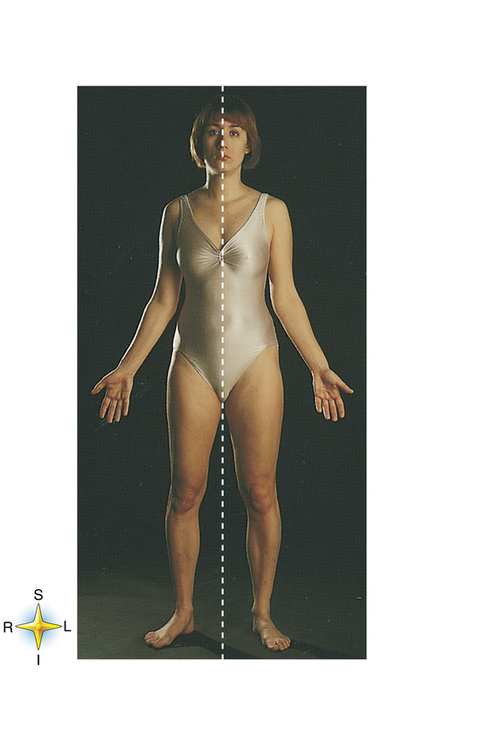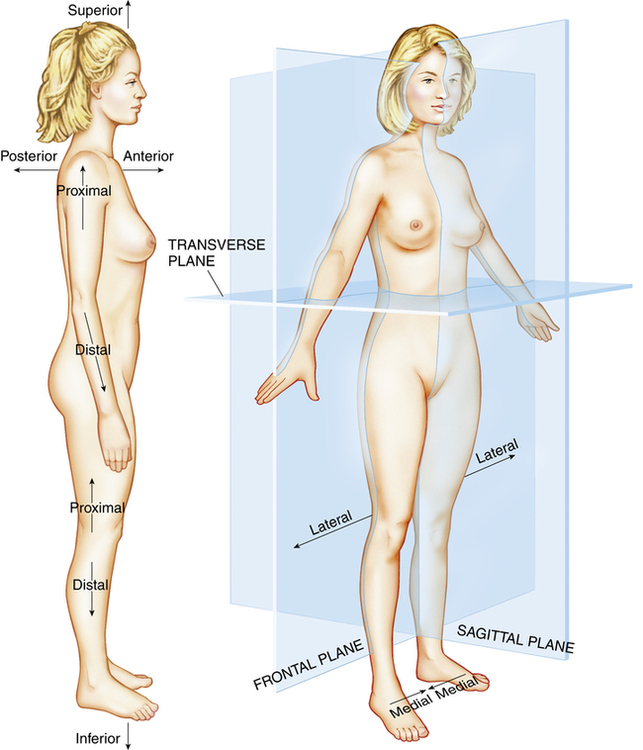11 After studying this chapter, the reader will be able to accomplish the following: • Distinguish between two branches of biology: anatomy and physiology. • Understand and describe the hierarchy of organization of the human body. • Describe the anatomic position. • Understand and define the descriptive and movement terminology. • Understand the cardinal planes and axes. • Describe the structures and functions of the organ systems of the human body. • Provide examples of pediatric health conditions or disorders of the organ systems of the human body. • Understand and describe the relationship among body structures, the function of body structures, and one’s successful engagement in daily occupations. The Occupational Therapy Practice Framework (OTPF) describes the domains and processes inherent to the profession of occupational therapy (OT). According to the OTPF, the term client factors refers to those components that influence actions or occupations.1 For example, a child’s neuromuscular status is considered a client factor. Client factors include both body structures and functions (Table 11-1). The term body structures refers to the parts that make up the human body. For example, the structure of the hand includes bones, muscles, tendons, nerves, and blood vessels. A child with a missing thumb would have a deficient body structure that may interfere with his occupational performance. The term body functions refers to how the body part, organ, or organ system works. In the former example, body function would include the child’s hand strength or coordination. Deficits in body functions may also result in poor occupational performance. Since body functions and body structures are essential to understanding occupational performance, this chapter provides an overview of the structures in each body system. Lastly, the author provides an overview of how body structures and body functions influence occupational performance. TABLE 11-1 Note. Some data adapted from the ICF (WHO, 2001). *Adapted from Table 2 from: American Occupational Therapy Association: Occupational therapy practice framework: Domain and process, 2nd edition, Am J Occup Ther 62(6):625–703, 2008. The organization of the human body is hierarchical. Atoms are the smallest unit of matter. By definition, matter is anything that takes up space and has mass or weight. Atoms of different elements have unique masses and space requirements. The most abundant elements found in living matter are carbon, hydrogen, oxygen, nitrogen, and phosphorus. Atoms link together (bond) to form molecules. For example, two hydrogen atoms bond with one oxygen atom to form one molecule of water (H2O). Molecules come together to form cells. Cells are the smallest units of living matter. The cells found in the human body are eukaryotic cells. Eukaryotic cells have a membrane bound nucleus that contains a person’s genetic information, for example, deoxyribonucleic acid (DNA) and genes. Cells come together to form tissues. There are four basic types of tissue found in the human body. The four tissue types are epithelial, connective, muscle, and nervous (Table 11-2). Tissues come together to form organs. Organs, for example, the heart, are made of two or more types of tissues. Organs come together to form organ systems, for example, the cardiovascular system, or the circulatory system, which consists of the heart and associated vessels. Organ systems come together to form organisms. The human body has numerous organ systems that work together to allow one’s active participation in chosen daily occupations. TABLE 11-2 From Patton KT: Anatomy and physiology, ed 7, St. Louis, 2009, Mosby. The OT practitioner needs to understand the interrelatedness of various organs and organ systems in the human body. Knowledge of the terminology that is used in the study of the human body’s structures and functions also is necessary. The anatomic position is used as a reference point when studying the anatomy and physiology of the human body. By definition, the term anatomic position refers to a person standing upright with the arms resting at the side of the body, palms forward, and the head and feet pointing forward. The fingers of both hands are adducted (not spread apart) (Figure 11-1). The human body has bilateral (two-sided) symmetry, that is, the right side of the body is a mirror image of the left side of the body.3,4 The human body is divided into front (anterior/ventral) and back (posterior/dorsal) cavities. Organ systems are located in specific regions of the ventral and dorsal cavities. The ventral cavity is subdivided into thoracic, abdominal, and pelvic cavities. The dorsal cavity is subdivided into cranial and spinal cavities (Figure 11-2). Knowledge of the three cardinal planes and their axes is important to understand the anatomy and physiology of the human body, especially when analyzing the cross-sections of structures and movements at individual joints. (1) The sagittal plane divides the body into left and right sides. If the body is divided into equal left and right parts, then the plane is called the midsaggital plane. The axis for the sagittal plane is the frontal axis, which is perpendicular to the saggital plane. (2) The frontal plane divides the human body into anterior and posterior parts. The axis for the frontal plane is the saggital axis. (3) The horizontal or transverse plane divides the body into upper and lower parts. The axis for the horizontal plane is the vertical axis. Specific movements occur in each of the three cardinal planes, and the axes are the points about which a body part rotates. For example, bending of the elbow occurs in the sagittal plane. The elbow joint rotates about the frontal axis. Understanding these concepts is crucial to the analysis and measurement of the range of motion (ROM) of joints (Figure 11-3).
Anatomy and physiology for the pediatric practitioner
CLIENT FACTORS
CATEGORY AND DEFINITION
EXAMPLES
Values: Principles, standards, or qualities considered worthwhile or desirable by the client who holds them.
Honesty with self and with others
Personal religious convictions
Commitment to family.
Beliefs: Cognitive content held as true.
He or she is powerless to influence others
Hard work pays off.
Spirituality: The “personal quest for understanding answers to ultimate questions about life, about meaning, and the sacred” (Moyers & Dale, 2007, p. 28).
Daily search for purpose and meaning in one’s life
Guiding actions from a sense of value beyond the personal acquisition of wealth or fame.
BODY FUNCTIONS
Categories
Mental Functions (affective, cognitive, perceptual)
Specific Mental Functions
Higher-level cognitive
Attention
Memory
Perception
Thought
Mental functions of sequencing complex movement
Emotional
Experience of self and time
Judgment, insight
Awareness, sustained, selective, attention
Short-term, long-term, and working memory
Discrimination, spatial, and temporal relationships
Recognition, categorization, generalization,
Execution of learned movement patterns
Coping, adapting
Body image, self-concept, self-esteem
Global Mental Functions
Consciousness
Orientation
Temperament and personality
Energy and drive
Sleep (physiological process)
Level of arousal, level of consciousness
Orientation to person, place, time, self, and others
Emotional stability
Motivation, impulse control, and appetite
Sensory Functions and Pain
Seeing and related functions
Hearing functions
Vestibular functions
Taste functions
Smell functions
Proprioceptive functions
Touch functions
Pain
Temperature and pressure
Detection/registration, modulation, and integration of sensations from the body and environment
Visual awareness
Sensation of securely moving against gravity
Association of taste & smell
Awareness of body position and space
Comfort with the feeling of being touched by others
Localizing pain
Thermal awareness
Neuromusculoskeletal and Movement-related Functions
Functions of joints and bones
Joint mobility
Joint stability
Muscle power
Muscle tone
Muscle endurance
Motor reflexes
Involuntary movement reactions
Control of voluntary movement
Gait patterns
ROM
Postural alignment
Strength
Degree of muscle tone (e.g., flaccidity, spasticity, fluctuating)
Endurance
Righting and supporting
Eye–hand/foot coordination, bilateral integration,
Walking patterns and impairments
Cardiovascular, Hematologic, Immunologic,
and Respiratory System Function
Cardiovascular system function
Hematological and immunological system function
Respiratory system function
Blood pressure functions (hypertension, hypotension, postural hypotension), and heart rate
Rate, rhythm, and depth of respiration
Physical endurance, aerobic capacity, stamina, and fatigability
Voice and Speech Functions
Digestive, Metabolic, and Endocrine System Function
Genitourinary and Reproductive Functions
Skin and Related-structure Functions
Protective functions of the skin–presence or absence of wounds, cuts, or abrasions
Repair function of the skin–wound healing
BODY STRUCTURES
Categories
Structure of the nervous system
Eyes, ear, and related structures
Structures involved in voice and speech
Structures of the cardiovascular, immunologic, and respiratory systems
Structures related to the digestive, metabolic, and endocrine systems
Structure related to the genitourinary and reproductive systems
Structures related to movement
Skin and related structures
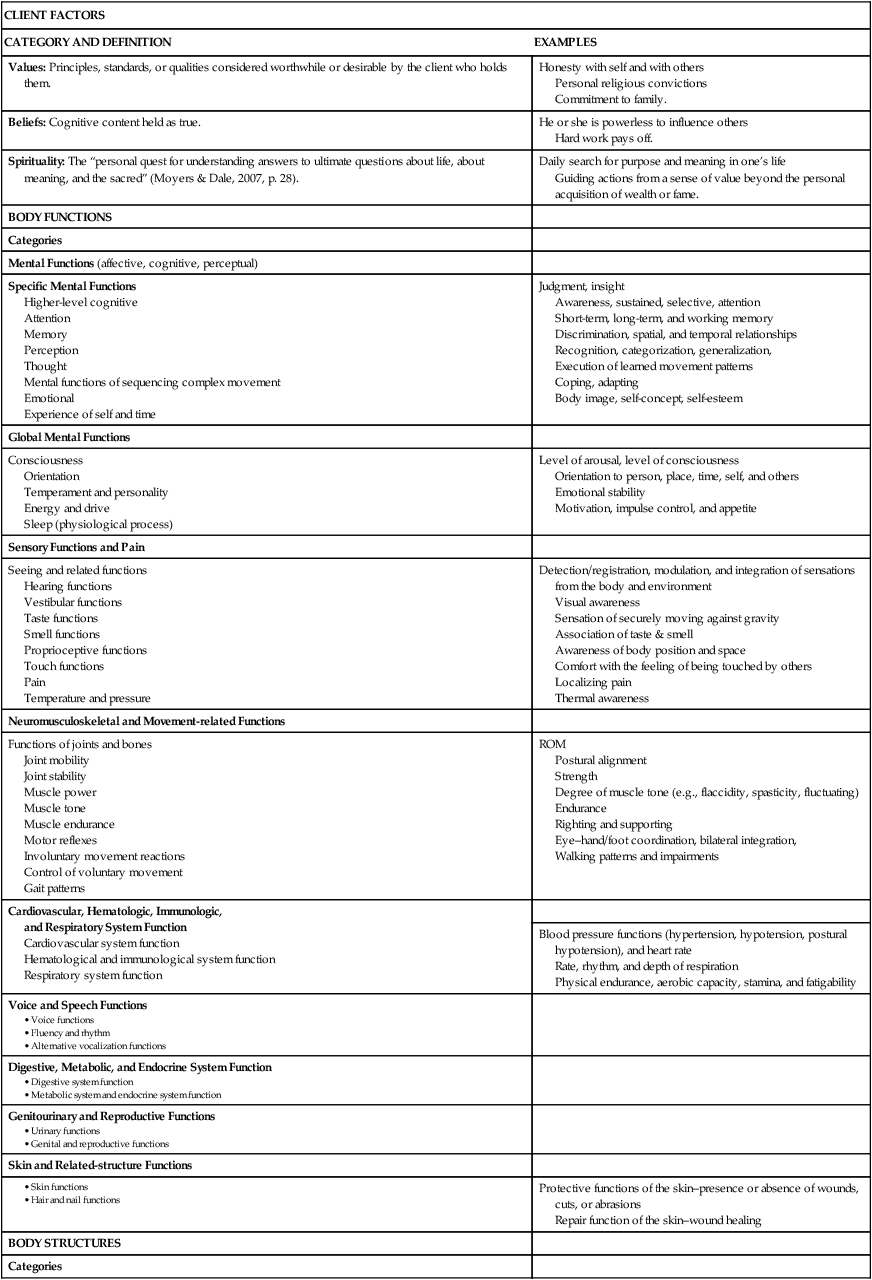

TISSUE TYPE
STRUCTURE
FUNCTION
EXAMPLES IN THE BODY
Epithelial
One or more layers of densely arranged cells with very little extracellular matrix
May form either sheets or glands
Covers and protects the body surface
Lines body cavities
Movement of substances (absorption, secretion, excretion)
Glandular activity
Outer layer of skin
Lining of the respiratory, digestive, urinary, reproductive tracts
Glands of the body
Connective
Sparsely arranged cells surrounded by a large proportion of extracellular matrix often containing structural fibers (and sometimes mineral crystals)
Supports body structures
Transports substances throughout the body
Bones
Joint cartilage
Tendons and ligaments
Blood
Fat
Muscle
Long fiberlike cells, sometimes branched, capable of pulling loads; extracellular fibers sometimes hold muscle fiber together
Produces body movements
Produces movements of organs such as the stomach, heart
Produces heat
Heart muscle
Muscles of the head/neck, arms, legs, trunk
Muscles in the walls of hollow organs such as the stomach, intestines
Nervous
Mixture of many cell types, including several types of neurons (conducting cells) and neuroglia (support cells)
Communication between body parts
Integration/regulation of body functions
Tissue of brain and spinal cord
Nerves of the body
Sensory organs of the body
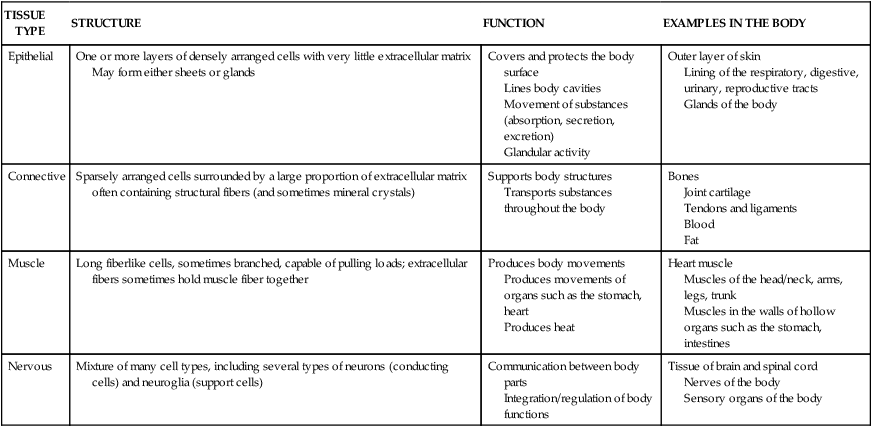
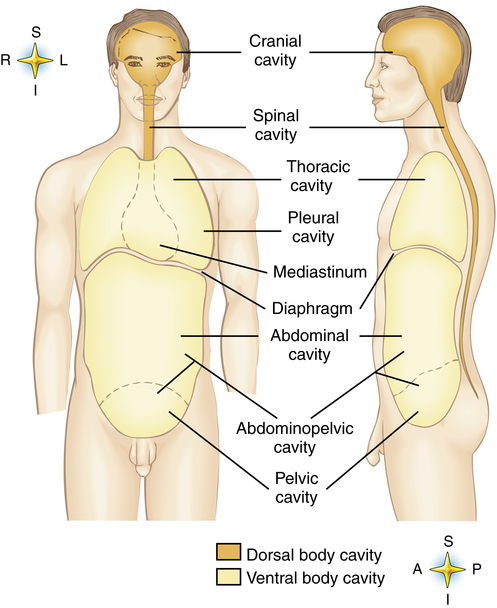
Terminology, planes, and axes
< div class='tao-gold-member'>
![]()
Stay updated, free articles. Join our Telegram channel

Full access? Get Clinical Tree


Anatomy and physiology for the pediatric practitioner
Only gold members can continue reading. Log In or Register to continue
